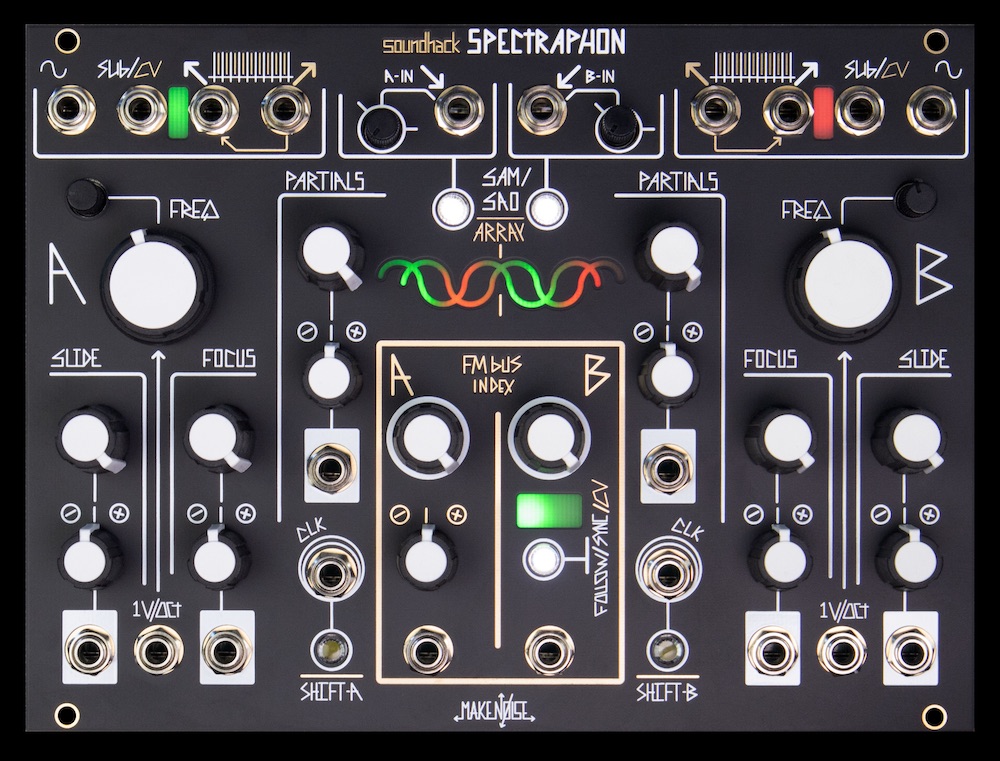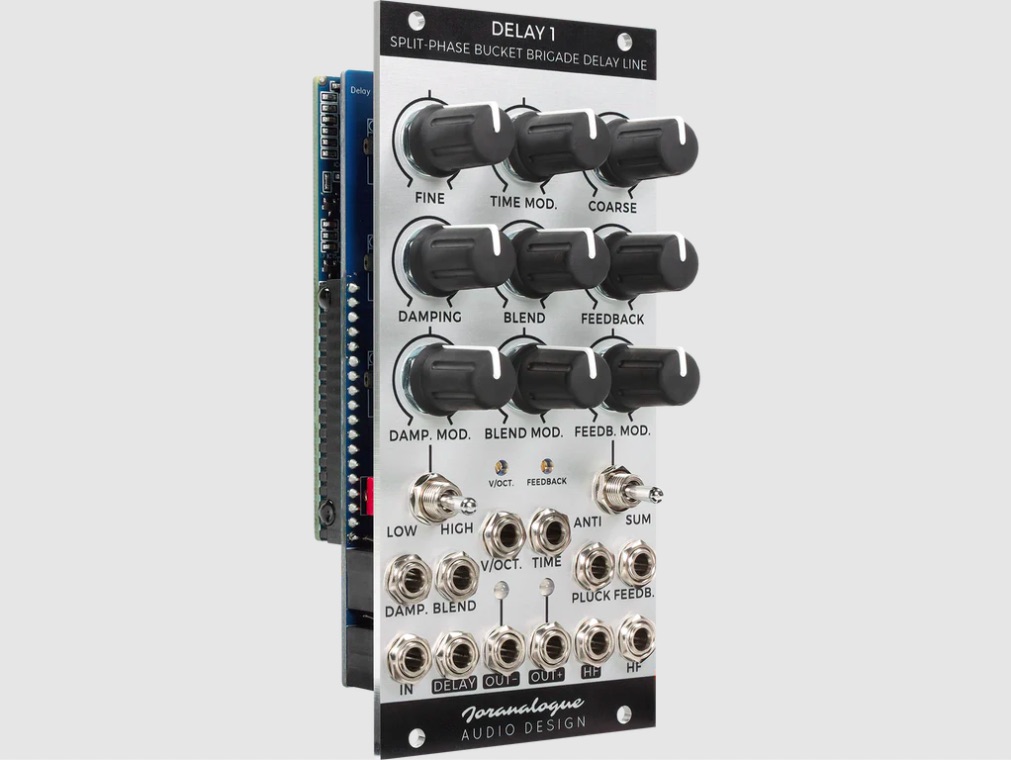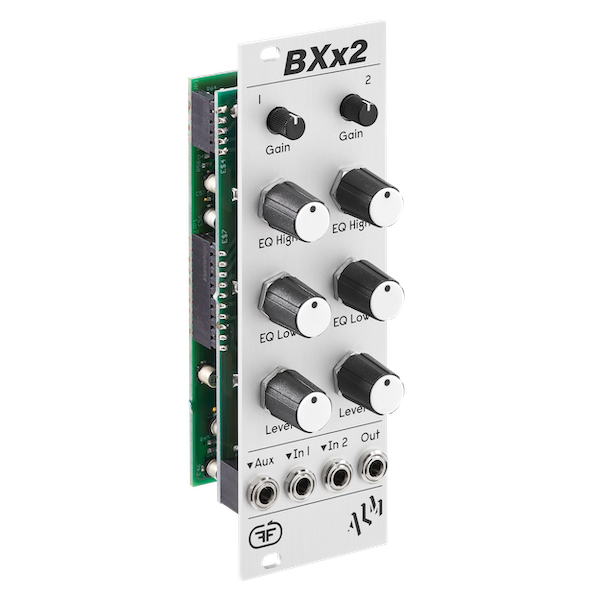August 2023 Eurorack round-up | Juno Daily
This month’s best new modules include a complex oscillator from Make Noise, contrasting delays from Joranalogue and 4ms, plus a superb kick module from Malstrom.

Make Noise/Soundhack Spectraphon
This month’s big new release is the Make Noise Spectraphon, a dual spectral oscillator which also represents the debut of a new hardware platform from the North Carolina brand. The Spectraphon is a collaborative effort with Soundhack, whose Tom Erbe contributed the code for the DSP. The Spectraphon is, in very simple terms, a digital take on the complex oscillator approach, whereby two oscillators are routed to modulate each other. The key difference here, compared to traditional analogue complex oscillators, is that the two (virtually identical) oscillators on each side of the module use real-time spectral analysis, resynthesising the input signal to create new sounds with similar spectral content. Spectral Amplitude Modulation mode requires an external input, while Spectral Array Oscillation is more like a conventional analogue oscillator. The results are hugely versatile, ranging from fragile, mangled manipulation of samples to and twisted percussive hits to more delicate, ethereal FM synth tones. Full review coming soon.

Dreadbox Telepathy
The Spectraphon couldn’t be much more different to Dreadbox’s Telepathy, a full synth voice module which follows a much more traditional approach. This is a deceptively powerful little module, packing a single analogue oscillator, sub oscillator, high-pass filter, resonant low-pass filter, analogue VCA, two envelopes and a complex LFO into just 10 HP. Accessing all the parameters of the module is handled via a programming matrix, which takes a bit of time to get used to but proves effective, allowing you to select ‘Pages’ in the matrix using two push buttons, then adjusting the settings using the four sliders. There are minimal patching options compared to having the same kind of features spread across separate modules, and there’s nothing particularly surprising about the sound, which is classic analogue fatness, but with storage for up to 16 presets and the ability to chain up to six modules for polyphonic playback, the Telepathy is more powerful than it looks. At just under £260, it’s a cost-effective starting point for classic analogue sounds and a particularly interesting starting point for Eurorack polyphony.

Malstrom Mandrake
Turning our attention from synths to drums, Malstrom’s Mandrake focuses firmly on the low end, designed (almost) exclusively for kicks. The Mandrake very quickly starts to feel like excellent value at £323 when you realise it’s a fully analogue kick module designed from the ground up. This isn’t designed to be a 909 or 808 clone – although it can get reasonably close if you want – but an ultra-versatile kick module designed to meet the needs of modern production techniques and generate sounds which work on club sound systems.
The synth circuits of the Mandrake are split into two control sections: Hit, which creates the transient at the start of the kick, and Body, which controls the rest of the sound. Adjusting the Hit is a simple case of choosing a timbre and volume, but the resonating filter controlled in the Body section has extensive controls, allowing you to dial in precise settings for pitch and decay, saturation, Damping (a low-pass filter), resonance and Clean-Up (which activates a high-pass filter and a 300 Hz EQ dip when applied, removing boxiness). A handy envelope output can be used to sidechain other sounds.
All in all, it’s a cohesive set of tools to create and perform with kick drums, lending itself very nicely to house and techno but capable of going into mellower and more melodic kick/bass territory too. Pitch the frequency up and you can also pull out some pretty sweet toms and even some more experimental zaps and blips. Very nice.

Joranalogue Delay 1 and 4ms Looping Delay
Next up, two delays which go about things in very different ways. In theory some of the features overlap, but in practice they achieve quite different effects. Joranalogue’s Delay 1 is based on 80s-style bucket brigade delay chips, famed for their slightly dark, lo-fi analogue character. What’s fun about the Delay 1 is the way the vintage delay concept has been brought up to date with precise clocking, a built-in compander to reduce noise and split phase outputs for mono-to-stereo effects. The result is a super vibey delay which can do all the classic echo, chorus and flanger effects with precise control and lots of CV modulation options. You can even do some superb Karplus-Strong synthesis effects via the pluck input.
4ms’s Looping Delay, on the other hand, is a proudly digital module, designed for precise, clean, tempo-synced delays and loops up to 90 seconds in length. The Looping Delay can do similar things to the Delay 1 at shorter delay times – including Karplus-Strong synthesis and cleaner chorus and flanging effects – but its real strengths lie in longer loops, sound-on-sound effects and synchronisation with other modules and sounds. At £260 for the Joranalogue module and £200 for the 4ms, they’re keenly enough priced that you could pair them together for the best of both worlds.

ALM BXx2
This one might sound familiar if you saw the Feedback Modules Pre BX we covered recently. Developed in conjunction with Feedback and based on the same circuits as the Pre BX, the BXx2 is ALM’s simple two-channel mixer based on the classic Boss BX series of mixers. Input gain and level controls let you push the pre-amp into sweet saturation, with simple two-band EQ and a mono output. A great way to add character to a couple of signals.
Greg Scarth
You may also be interested in…


